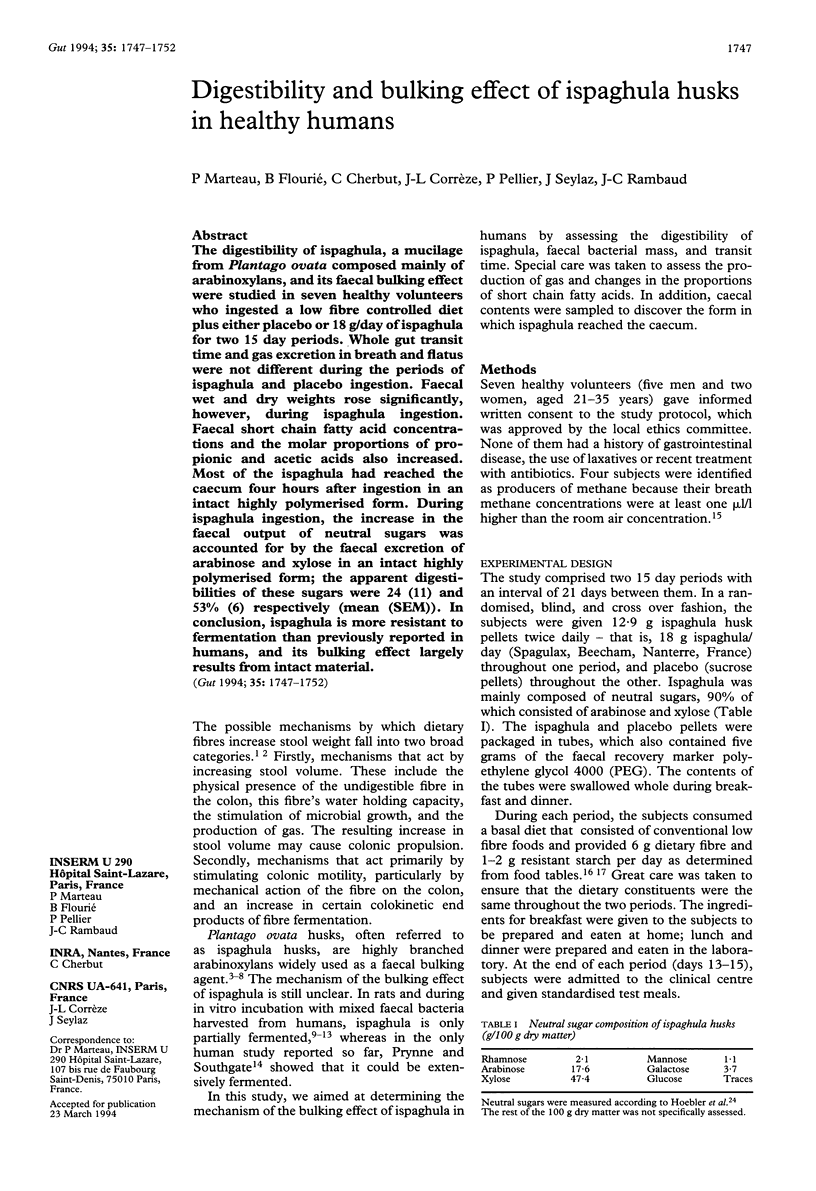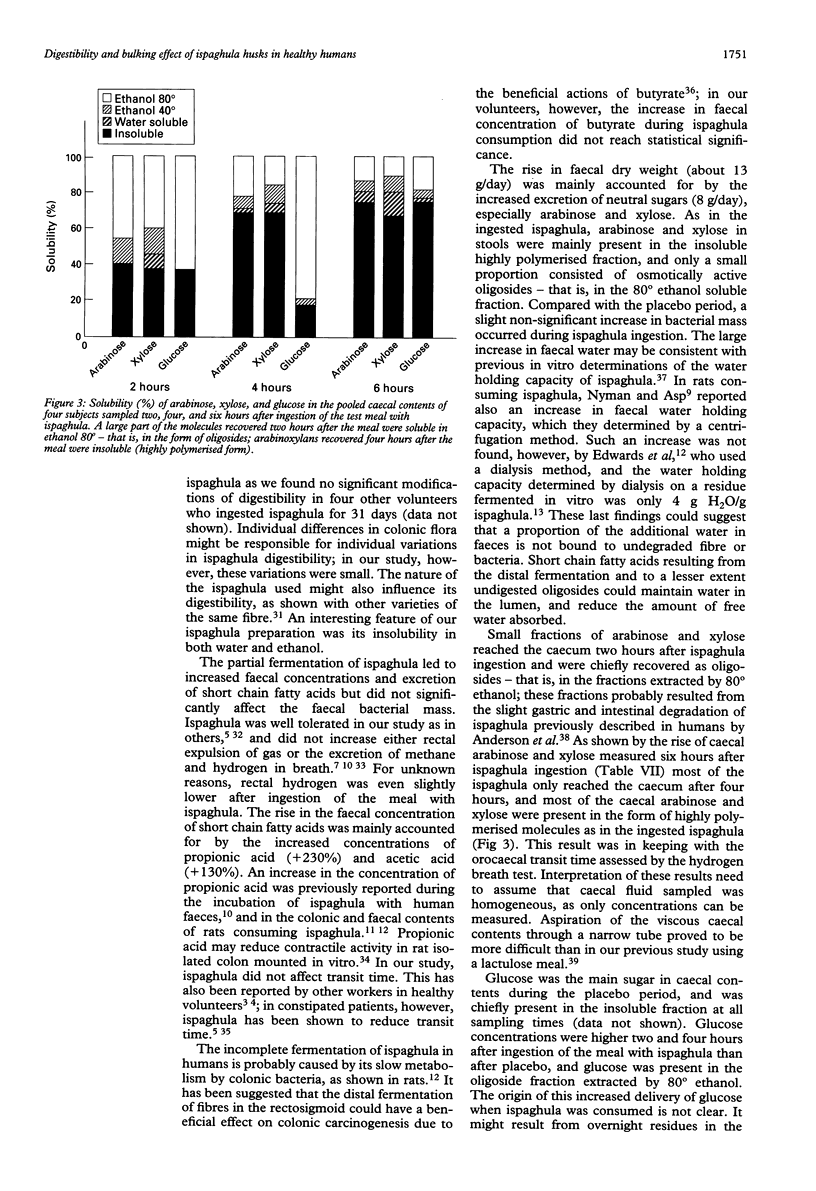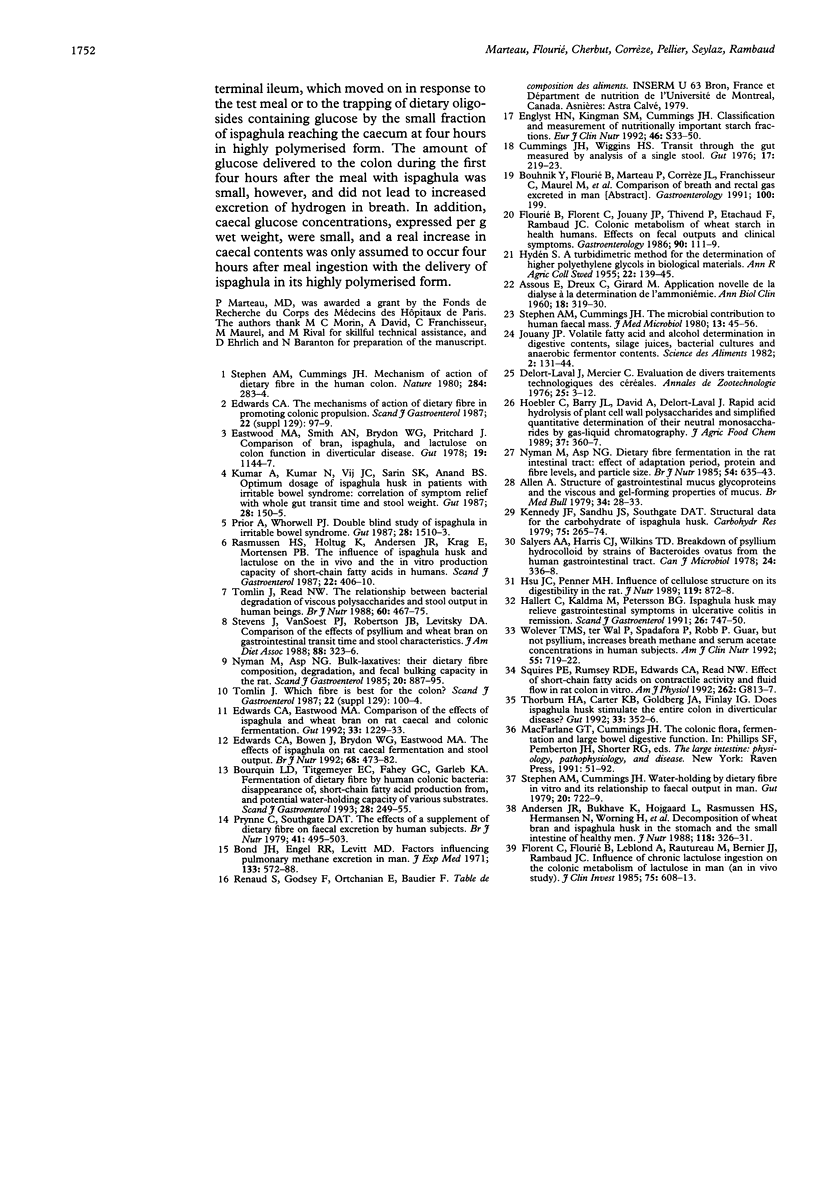Abstract
The digestibility of ispaghula, a mucilage from Plantago ovata composed mainly of arabinoxylans, and its faecal bulking effect were studied in seven healthy volunteers who ingested a low fibre controlled diet plus either placebo or 18 g/day of ispaghula for two 15 day periods. Whole gut transit time and gas excretion in breath and flatus were not different during the periods of ispaghula and placebo ingestion. Faecal wet and dry weights rose significantly, however, during ispaghula ingestion. Faecal short chain fatty acid concentrations and the molar proportions of propionic and acetic acids also increased. Most of the ispaghula had reached the caecum four hours after ingestion in an intact highly polymerised form. During ispaghula ingestion, the increase in the faecal output of neutral sugars was accounted for by the faecal excretion of arabinose and xylose in an intact highly polymerised form; the apparent digestibilities of these sugars were 24 (11) and 53% (6) respectively (mean (SEM)). In conclusion, ispaghula is more resistant to fermentation than previously reported in humans, and its bulking effect largely results from intact material.
Full text
PDF





Selected References
These references are in PubMed. This may not be the complete list of references from this article.
- ASSOUS E., DREUX C., GIRARD M. [Further use of dialysis in the determination of ammonia in the blood]. Ann Biol Clin (Paris) 1960 May-Jun;18:319–330. [PubMed] [Google Scholar]
- Allen A. Structure of gastrointestinal mucus glycoproteins and the viscous and gel-forming properties of mucus. Br Med Bull. 1978 Jan;34(1):28–33. [PubMed] [Google Scholar]
- Andersen J. R., Bukhave K., Højgaard L., Rasmussen H. S., Hermansen N., Worning H., Krag E. Decomposition of wheat bran and ispaghula husk in the stomach and the small intestine of healthy men. J Nutr. 1988 Mar;118(3):326–331. doi: 10.1093/jn/118.3.326. [DOI] [PubMed] [Google Scholar]
- Bond J. H., Jr, Engel R. R., Levitt M. D. Factors influencing pulmonary methane excretion in man. An indirect method of studying the in situ metabolism of the methane-producing colonic bacteria. J Exp Med. 1971 Mar 1;133(3):572–588. doi: 10.1084/jem.133.3.572. [DOI] [PMC free article] [PubMed] [Google Scholar]
- Bourquin L. D., Titgemeyer E. C., Fahey G. C., Jr, Garleb K. A. Fermentation of dietary fibre by human colonic bacteria: disappearance of, short-chain fatty acid production from, and potential water-holding capacity of, various substrates. Scand J Gastroenterol. 1993 Mar;28(3):249–255. doi: 10.3109/00365529309096081. [DOI] [PubMed] [Google Scholar]
- Conlon J. M., Deacon C. F., Richter G., Stöckmann F., Creutzfeldt W. Circulating tachykinins (substance P, neurokinin A, neuropeptide K) and the carcinoid flush. Scand J Gastroenterol. 1987 Jan;22(1):97–105. doi: 10.3109/00365528708991864. [DOI] [PubMed] [Google Scholar]
- Cummings J. H., Wiggins H. S. Transit through the gut measured by analysis of a single stool. Gut. 1976 Mar;17(3):219–223. doi: 10.1136/gut.17.3.219. [DOI] [PMC free article] [PubMed] [Google Scholar]
- Eastwood M. A., Smith A. N., Brydon W. G., Pritchard J. Comparison of bran, ispaghula, and lactulose on colon function in diverticular disease. Gut. 1978 Dec;19(12):1144–1147. doi: 10.1136/gut.19.12.1144. [DOI] [PMC free article] [PubMed] [Google Scholar]
- Edwards C. A., Bowen J., Brydon W. G., Eastwood M. A. The effects of ispaghula on rat caecal fermentation and stool output. Br J Nutr. 1992 Sep;68(2):473–482. doi: 10.1079/bjn19920105. [DOI] [PubMed] [Google Scholar]
- Edwards C. A., Eastwood M. A. Comparison of the effects of ispaghula and wheat bran on rat caecal and colonic fermentation. Gut. 1992 Sep;33(9):1229–1233. doi: 10.1136/gut.33.9.1229. [DOI] [PMC free article] [PubMed] [Google Scholar]
- Englyst H. N., Kingman S. M., Cummings J. H. Classification and measurement of nutritionally important starch fractions. Eur J Clin Nutr. 1992 Oct;46 (Suppl 2):S33–S50. [PubMed] [Google Scholar]
- Florent C., Flourie B., Leblond A., Rautureau M., Bernier J. J., Rambaud J. C. Influence of chronic lactulose ingestion on the colonic metabolism of lactulose in man (an in vivo study). J Clin Invest. 1985 Feb;75(2):608–613. doi: 10.1172/JCI111738. [DOI] [PMC free article] [PubMed] [Google Scholar]
- Flourie B., Florent C., Jouany J. P., Thivend P., Etanchaud F., Rambaud J. C. Colonic metabolism of wheat starch in healthy humans. Effects on fecal outputs and clinical symptoms. Gastroenterology. 1986 Jan;90(1):111–119. doi: 10.1016/0016-5085(86)90082-x. [DOI] [PubMed] [Google Scholar]
- Hallert C., Kaldma M., Petersson B. G. Ispaghula husk may relieve gastrointestinal symptoms in ulcerative colitis in remission. Scand J Gastroenterol. 1991 Jul;26(7):747–750. doi: 10.3109/00365529108998594. [DOI] [PubMed] [Google Scholar]
- Hsu J. C., Penner M. H. Influence of cellulose structure on its digestibility in the rat. J Nutr. 1989 Jun;119(6):872–878. doi: 10.1093/jn/119.6.872. [DOI] [PubMed] [Google Scholar]
- Kumar A., Kumar N., Vij J. C., Sarin S. K., Anand B. S. Optimum dosage of ispaghula husk in patients with irritable bowel syndrome: correlation of symptom relief with whole gut transit time and stool weight. Gut. 1987 Feb;28(2):150–155. doi: 10.1136/gut.28.2.150. [DOI] [PMC free article] [PubMed] [Google Scholar]
- Nyman M., Asp N. G. Bulk laxatives: their dietary fibre composition, degradation, and faecal bulking capacity in the rat. Scand J Gastroenterol. 1985 Sep;20(7):887–895. doi: 10.3109/00365528509088841. [DOI] [PubMed] [Google Scholar]
- Nyman M., Asp N. G. Dietary fibre fermentation in the rat intestinal tract: effect of adaptation period, protein and fibre levels, and particle size. Br J Nutr. 1985 Nov;54(3):635–643. doi: 10.1079/bjn19850150. [DOI] [PubMed] [Google Scholar]
- Prior A., Whorwell P. J. Double blind study of ispaghula in irritable bowel syndrome. Gut. 1987 Nov;28(11):1510–1513. doi: 10.1136/gut.28.11.1510. [DOI] [PMC free article] [PubMed] [Google Scholar]
- Prynne C. J., Southgate D. A. The effects of a supplement of dietary fibre on faecal excretion by human subjects. Br J Nutr. 1979 May;41(3):495–503. doi: 10.1079/bjn19790064. [DOI] [PubMed] [Google Scholar]
- Rasmussen H. S., Holtug K., Andersen J. R., Krag E., Mortensen P. B. The influence of ispaghula husk and lactulose on the in vivo and the in vitro production capacity of short-chain fatty acids in humans. Scand J Gastroenterol. 1987 May;22(4):406–410. doi: 10.3109/00365528708991482. [DOI] [PubMed] [Google Scholar]
- Salyers A. A., Harris C. J., Wilkins T. D. Breakdown of psyllium hydrocolloid by strains of Bacterioides ovatus from the human intestinal tract. Can J Microbiol. 1978 Mar;24(3):336–338. doi: 10.1139/m78-057. [DOI] [PubMed] [Google Scholar]
- Squires P. E., Rumsey R. D., Edwards C. A., Read N. W. Effect of short-chain fatty acids on contractile activity and fluid flow in rat colon in vitro. Am J Physiol. 1992 May;262(5 Pt 1):G813–G817. doi: 10.1152/ajpgi.1992.262.5.G813. [DOI] [PubMed] [Google Scholar]
- Stephen A. M., Cummings J. H. Mechanism of action of dietary fibre in the human colon. Nature. 1980 Mar 20;284(5753):283–284. doi: 10.1038/284283a0. [DOI] [PubMed] [Google Scholar]
- Stephen A. M., Cummings J. H. The microbial contribution to human faecal mass. J Med Microbiol. 1980 Feb;13(1):45–56. doi: 10.1099/00222615-13-1-45. [DOI] [PubMed] [Google Scholar]
- Stephen A. M., Cummings J. H. Water-holding by dietary fibre in vitro and its relationship to faecal output in man. Gut. 1979 Aug;20(8):722–729. doi: 10.1136/gut.20.8.722. [DOI] [PMC free article] [PubMed] [Google Scholar]
- Stevens J., VanSoest P. J., Robertson J. B., Levitsky D. A. Comparison of the effects of psyllium and wheat bran on gastrointestinal transit time and stool characteristics. J Am Diet Assoc. 1988 Mar;88(3):323–326. [PubMed] [Google Scholar]
- Thorburn H. A., Carter K. B., Goldberg J. A., Finlay I. G. Does ispaghula husk stimulate the entire colon in diverticular disease? Gut. 1992 Mar;33(3):352–356. doi: 10.1136/gut.33.3.352. [DOI] [PMC free article] [PubMed] [Google Scholar]
- Tomlin J., Read N. W. The relation between bacterial degradation of viscous polysaccharides and stool output in human beings. Br J Nutr. 1988 Nov;60(3):467–475. doi: 10.1079/bjn19880119. [DOI] [PubMed] [Google Scholar]
- Tomlin J. Which fibre is best for the colon? Scand J Gastroenterol Suppl. 1987;129:100–104. doi: 10.3109/00365528709095860. [DOI] [PubMed] [Google Scholar]
- Wolever T. M., ter Wal P., Spadafora P., Robb P. Guar, but not psyllium, increases breath methane and serum acetate concentrations in human subjects. Am J Clin Nutr. 1992 Mar;55(3):719–722. doi: 10.1093/ajcn/55.3.719. [DOI] [PubMed] [Google Scholar]


